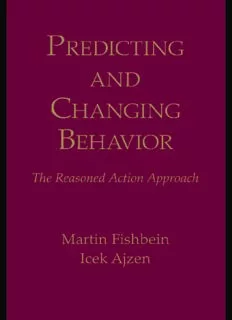
Predicting and Changing Behavior: The Reasoned Action Approach PDF
Preview Predicting and Changing Behavior: The Reasoned Action Approach
P redicting and c hanging B ehavior P redicting and c hanging B ehavior The Reasoned Action Approach Martin Fishbein Icek Ajzen Psychology Press Psychology Press Taylor & Francis Group Taylor & Francis Group 270 Madison Avenue 27 Church Road New York, NY 10016 Hove, East Sussex BN3 2FA © 2010 by Taylor and Francis Group, LLC This edition published in the Taylor & Francis e-Library, 2011. To purchase your own copy of this or any of Taylor & Francis or Routledge’s collection of thousands of eBooks please go to www.eBookstore.tandf.co.uk. Psychology Press is an imprint of Taylor & Francis Group, an Informa business International Standard Book Number: 978-0-8058-5924-9 (Hardback) For permission to photocopy or use material electronically from this wor k, please access www. copyright.com (http://www.copyright.com/) or contact the Copyright Clearance Center, Inc. (CCC), 222 Rosewood Drive, Danvers, MA 01923, 978-750-8400. CCC is a not-for-profit organiza- tion that provides licenses and registration for a variety of users. For organizations that have been granted a photocopy license by the CCC, a separate system of payment has been arranged. Trademark Notice: Product or corporate names may be trademarks or registered trademarks, and are used only for identification and explanation with out intent to infringe. Library of Congress Cataloging‑in‑Publication Data Fishbein, Martin. Predicting and changing behavior : the reasoned action approach / Martin Fishbein and Icek Ajzen. p. cm. Includes bibliographical references and index. ISBN 978-0-8058-5924-9 (hard back : alk. paper) 1. Behavior modification. 2. Expectation (Psychology) 3. Human behavior. I. Ajzen, Icek. II. Title. BF637.B4F57 2010 153.8’5--dc22 2009020871 Visit the Taylor & Francis Web site at http://www.taylorandfrancis.com and the Psychology Press Web site at http://www.psypress.com ISBN 0-203-83802-5 Master e-book ISBN This book is dedicated to: My wife, Deborah, for making the impossible, possible The memory of my parents—Gloria and Sydney Fishbein Les Squier, Bert Raven, and Irv Maltzman for teaching me what it means to be a psychologist and teacher. And to Rachela, for being there when I need her, and to Ron and Jonathan, for just being there. Contents Preface xvii Chapter 1 Introduction 1 Approaches and Explanatory Constructs 2 Organizational Behavior 3 Job Performance 3 Turnover and Other Withdrawal Behaviors 4 Political Behavior 5 Voting Participation 6 Voting Choice 8 Discriminatory Behavior 1 1 Empirical Findings 1 1 Implicit Versus Explicit Measures of Prejudice 1 4 Empirical Evidence 1 5 Discussion 17 The Reasoned Action Approach 2 0 The Nature of Reasoned Action 2 3 Background Factors 2 4 Related Reasoned Action Models 2 5 Conclusion 2 7 Chapter 2 Defining and Predicting Behavior 2 9 Levels of Generality 3 0 Direct Observation Versus Self-Reports of Behavior 3 2 Varieties of Behavioral Criteria 3 4 Dichotomies, Frequencies, and Magnitudes 34 Behavioral Categories 3 5 vii viii Contents Validity of Self-Reports 3 7 Behaviors Versus Goals 3 8 Predicting Behavior 3 9 The Concept of Intention 3 9 Behavioral Expectations and Willingness 4 0 Behavioral Expectation 4 1 Willingness 4 2 Using Intentions to Predict Behavior 4 3 The Principle of Compatibility 4 4 Single-Act Dichotomous Criteria 4 4 Single-Act Continuous Criteria 4 5 Behavioral Categories 4 7 Empirical Support for Prediction of Behavior From Intentions 4 8 Self-Reports Versus Objective Measures of Behavior 48 Prospective Versus Retrospective Measures of Behavior 4 9 Prediction of Routine Behaviors 5 1 Automaticity 5 1 Factors Influencing the Predictive Validity of Intentions 5 3 Compatibility 5 4 Temporal Stability of Intentions 5 6 Sequential Hurdles 5 7 Volitional Control 5 7 Memory for Intentions 5 9 Intention–Behavior Gap: Literal Inconsistency 5 9 Pseudo-Inconsistency: An Explanation of Literal Inconsistency 6 0 Hypothetical Versus Real Situations 6 2 Perceived Behavioral Control 6 4 Definition and Measurement of Perceived Behavioral Control 6 4 Empirical Support for the Predictive Validity of Perceived Behavioral Control 65 Moderating Effects of Perceived Behavioral Control 65 Additive Effects of Intentions and Perceived Behavioral Control 6 6 Methodological Considerations in the Prediction of Behavior 6 8 Restriction of Range: Floor and Ceiling Effects 6 9 Contents ix Summary and Conclusions 7 1 Notes 7 3 Chapter 3 Attitudes and Their Determinants 7 5 Definition of Attitude 7 5 Attitude Versus Affect 7 7 Measuring Attitudes 7 9 The Semantic Differential 7 9 Instrumental Versus Experiential Aspects of Attitude 8 2 Belief-Based Measures of Attitude 8 5 Factor Analysis of Attitudinal Items 88 Can Items and Factors Be Used to Explain an Underlying Attitude? 9 2 Including Factual and Ambivalent Items in Attitude Scales 9 4 The Expectancy-Value Model of Attitude 9 6 Beliefs as a Basis of Attitudes 9 6 Salient Beliefs 9 8 Eliciting Salient Beliefs 100 Empirical Support for the Expectancy-Value Model 103 Predictive Validity of Salient Versus Nonsalient Beliefs 104 Scoring Belief Strength 105 Disagreement With Belief Statements 107 Issues Related to the Expectancy-Value Model 110 Importance of Accessible Beliefs 110 Multiplicative Combination Rule 113 Attitudinal Ambivalence 118 Illustration of the Expectancy-Value Approach to Attitude 120 Summary and Conclusions 125 Notes 127 Chapter 4 Perceived Norms and Their Determinants 129 Perceived Social Pressure 130 Compliance With Perceived Social Pressure 130 Injunctive Versus Descriptive Norms 131 Injunctive Norms 133 Determinants of Injunctive Norms 134 Modal Normative Beliefs 139
Description: